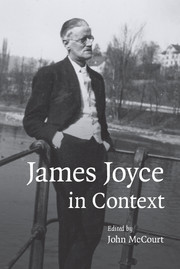Book contents
- Frontmatter
- Contents
- Notes on contributors
- Preface
- List of abbreviations
- PART I LIFE AND WORKS
- PART II THEORY AND CRITICAL RECEPTION
- PART III HISTORICAL AND CULTURAL CONTEXTS
- 14 Being in Joyce's world
- 15 Dublin
- 16 Nineteenth-century lyric nationalism
- 17 The Irish Revival
- 18 The English literary tradition
- 19 Paris
- 20 Trieste
- 21 Greek and Roman themes
- 22 Medicine
- 23 Modernisms
- 24 Music
- 25 Irish and European politics: nationalism, socialism, empire
- 26 Newspapers and popular culture
- 27 Language and languages
- 28 Philosophy
- 29 Religion
- 30 Science
- 31 Cinema
- 32 Sex
- Further reading
- Index
24 - Music
Published online by Cambridge University Press: 14 July 2009
- Frontmatter
- Contents
- Notes on contributors
- Preface
- List of abbreviations
- PART I LIFE AND WORKS
- PART II THEORY AND CRITICAL RECEPTION
- PART III HISTORICAL AND CULTURAL CONTEXTS
- 14 Being in Joyce's world
- 15 Dublin
- 16 Nineteenth-century lyric nationalism
- 17 The Irish Revival
- 18 The English literary tradition
- 19 Paris
- 20 Trieste
- 21 Greek and Roman themes
- 22 Medicine
- 23 Modernisms
- 24 Music
- 25 Irish and European politics: nationalism, socialism, empire
- 26 Newspapers and popular culture
- 27 Language and languages
- 28 Philosophy
- 29 Religion
- 30 Science
- 31 Cinema
- 32 Sex
- Further reading
- Index
Summary
It is readily apparent to any reader that a musical sensibility lies behind the poetry, drama and fiction of James Joyce. Joyce's characters include concert pianists, church musicians, professional singers, voice teachers and even a blind piano tuner. Ordinary Dubliners in his fiction have long memories of the musical life of their city, a canny awareness of the idiosyncrasies of singers and the ability to perform in company when asked to do so. Joyce's characters also have unusually good ears: Stephen Dedalus, in A Portrait, can identify the birdcall from Wagner's Siegfried (P 258) and describe a musical motive interval by interval (P 179), while even a non-musician like Leopold Bloom can hum opera tunes (U 5.228), hear three-quarter time in the clanking of press machinery (7.101) and identify harmonic overtones in the chiming of a church bell (4.549–50). ‘Clay’, ‘A Mother’ and ‘The Dead’ revolve around musical performances, and a mundane meeting about a concert programme creates a pretext for the most significant event of a warm June day in 1904 Dublin. Bits of music or whole songs, one composed by Joyce himself, are printed in musical notation in both Ulysses and Finnegans Wake. The sound of music is registered in Joyce's rhythmic prose and evoked, continually, in readers who share his love of music.
The attraction to music as what Joseph Conrad called the ‘art of arts’ was a constant in European literature, beginning as early as the Romantic movement and extending well into the twentieth century.
- Type
- Chapter
- Information
- James Joyce in Context , pp. 275 - 284Publisher: Cambridge University PressPrint publication year: 2009



